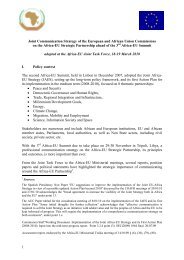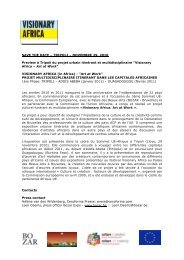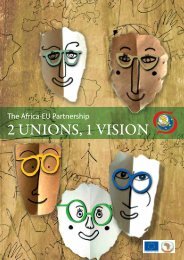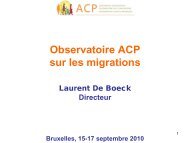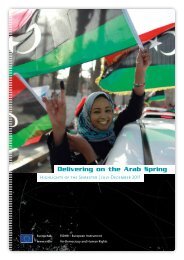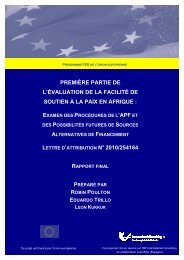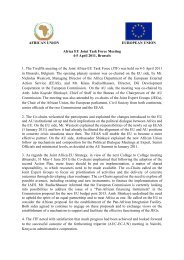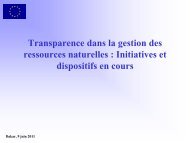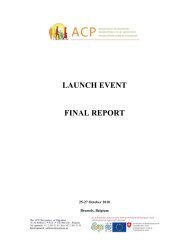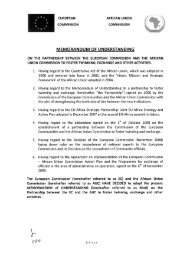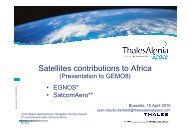part 1 of the african peace facility evaluation - European ...
part 1 of the african peace facility evaluation - European ...
part 1 of the african peace facility evaluation - European ...
Create successful ePaper yourself
Turn your PDF publications into a flip-book with our unique Google optimized e-Paper software.
<strong>European</strong> Parliament and NGOs continue to question <strong>the</strong> rationale. The use <strong>of</strong> development funds<br />
was recently justified thus by <strong>the</strong> AUC Chief <strong>of</strong> Staff 29 :<br />
‘… Of <strong>the</strong> many challenges facing our continent, <strong>the</strong> quest for <strong>peace</strong> and security is<br />
undoubtedly <strong>the</strong> most pressing. Issues <strong>of</strong> <strong>peace</strong> and security have always been at <strong>the</strong><br />
core <strong>of</strong> <strong>the</strong> concerns <strong>of</strong> African leaders, for this is a prerequisite for <strong>the</strong> development<br />
<strong>of</strong> our continent and its peoples.’<br />
II.4 APF AND JAES PARTNERSHIPS<br />
From its creation, <strong>part</strong>nership has been one <strong>of</strong> <strong>the</strong> key principles <strong>of</strong> APF. The Joint Africa-EU Strategy<br />
(JAES) is built on eight <strong>part</strong>nerships, replacing donations as <strong>the</strong> driving force <strong>of</strong> <strong>the</strong> EU’s long-term<br />
commitment to Africa. The first <strong>of</strong> <strong>the</strong>se <strong>part</strong>nerships is Peace & Security and directly concerns APF<br />
as <strong>the</strong> AU’s primary <strong>part</strong>ner for P&S. A JAES mid-term review in Addis on 14 October 2009 concluded<br />
that:<br />
‘JAES needs to encourage more active <strong>part</strong>icipation and buy-in from individual<br />
Members States and African Regional Economic Communities (RECs). It will also<br />
need to stimulate greater involvement <strong>of</strong> civil society and <strong>the</strong> private sector if <strong>the</strong> full<br />
potential <strong>of</strong> <strong>the</strong> <strong>part</strong>nership is to be realised. Likewise, attention should be paid to<br />
diversifying and expanding <strong>the</strong> resources available to <strong>the</strong> Joint Strategy in order to<br />
ensure that it has access to <strong>the</strong> funds needed to achieve its goals.’<br />
APF came into <strong>the</strong> JAES P&S <strong>part</strong>nership as a flagship financial <strong>facility</strong>, but it should be assessed<br />
whe<strong>the</strong>r it fully responds to <strong>the</strong> needs <strong>of</strong> <strong>the</strong> JAES and <strong>the</strong> entire range <strong>of</strong> specific objectives outlined<br />
in <strong>the</strong> II Action Plan (2011-2013). The JAES and <strong>the</strong> Paris Declaration <strong>of</strong> 2005 reinforced concepts <strong>of</strong><br />
African ownership, which had already been introduced into <strong>the</strong> APF with <strong>the</strong> NIP slicing mechanism.<br />
Never<strong>the</strong>less, even without NIP co-funding in <strong>the</strong> second APF, <strong>the</strong>re is still some joint AU MS<br />
ownership <strong>of</strong> APSA and all <strong>the</strong> PSOs through <strong>the</strong> AU’s elected, 15-member, Peace and Security<br />
Council.<br />
Resources for <strong>the</strong> Peace and Security Partnership <strong>of</strong> <strong>the</strong> Joint Africa•EU Strategy (JAES) mainly<br />
come from <strong>the</strong> <strong>European</strong> Commission through <strong>the</strong> EDF. As said above, reluctance about development<br />
money funding PSOs might disappear if greater political attention was paid to <strong>the</strong> non-military aspects<br />
<strong>of</strong> PSOs and complementary actions involving conflict management and mediation actions. In <strong>part</strong>,<br />
this may also be a communication issue: APF instrument is not good in communication outreach or<br />
working with <strong>the</strong> relevant actors beyond <strong>the</strong> organisational secretariats in <strong>the</strong> AUC and RECs (inter<br />
alia civil society, specialised entities, research institutions, private sector or individual AU member<br />
states). The information contained in lengthy written reports is not easy to disseminate to<br />
stakeholders. The result is that <strong>the</strong> APF and APSA operationalisations are insufficiently understood<br />
outside <strong>the</strong> bureaucratic circles <strong>of</strong> a limited number <strong>of</strong> administrative services.<br />
In that sense, <strong>the</strong> increasing importance <strong>of</strong> ERM should be highlighted as essentially reactive. Its<br />
creation was an innovative move and it has proven a very valuable prevention tool. The weakness lies<br />
in <strong>the</strong> fact that ERM actions are not linked to any longer-term APSA capacity building or AU<br />
institutional building process, such as <strong>the</strong> Panel <strong>of</strong> <strong>the</strong> Wise. They are one-<strong>of</strong>f missions and while <strong>the</strong><br />
individual mediation mission may be a success, <strong>the</strong> process is not built into APSA and does not<br />
necessarily increase AU or REC institutional capacity for mediation.<br />
29 Shinkaiye, Ambassador John K. 2010. Ensuring Peace and Security in Africa: Implementing <strong>the</strong> New Africa-<br />
EU Partnership, Chatham House Transcript, London, 27 October 2010.<br />
Page 15 <strong>of</strong> 49




